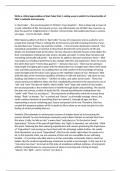Write a critical appreciation of East Coker Part I, noting ways in which it is characteristic of
Eliot’s methods and concerns.
In ‘East Coker’ - the second quartet of TS Eliot’s ‘Four Quartets’ - time is observed as more of
a cyclic reflection of life. Permanent as ever, war still remains one of Eliot’s key concerns, as
does his quest for enlightenment; in Section I of East Coker, Eliot addresses these in concise
yet vague – true to his style– detail.
Eliot imposes patterns of time in ‘East Coker’ by way of reassurance and as a plea for us to
accept time instead of fear it. Linking this to the horrors and still remaining tremors of war,
he describes how “houses rise and fall, crumble… / Are removed, destroyed, restored.” The
syntactical composition of commas in this phrase denotes the cyclic process of life and
death: one inevitably leads to the other. He may choose to describe houses as the object for
their connotations of being not only secure, durable and solid - to show that everyone and
everything eventually will perish – but also for its ability to become someone’s home – Eliot
may imply our emotional preferences also change with time and experience. Given he wrote
this when they were “l’entre deux guerres” – between two wars – Eliot may be aiming to
help people in England get to grips with the destruction war wrought upon them, their loved
ones and their possessions, by enabling them to seek comfort in the knowledge of having
some foresight into the future and a grasp on the repetitive nature of war. Moreover, Eliot
drills this idea of the imminent repetition of history in with the half lines: “old stone to new
building, old timber to new fires”, “old fires to ashes, and ashes to the earth”. These two
verses portray two different ideas; the first, simplistically presents by the oxymoronic use of
“old” and “new” the idea of rebirth, which instills “new” hope and comfort in the reader;
the second provides a less evident form of rebirth through death and perishing. The second
line does not convey a switch of death for life, instead describing the sinking down into
“earth” with “flesh, fur and faeces”. This triumvirate of alliterative words tie in these three
things: “flesh” as human, “fur” as animal and “faeces” as all worldly wastage. Hence, the
earth contains elements of everything that has roamed it, through all ages and thus
representing a source containing past, future and present all in one. Therefore, Eliot has
created this perpetual pattern of life to death to life to show us we must not give in to the
feeling of unrest pervading that era.
Similarly, Eliot attempts to retrieve past customs of simpler times by first enacting the
process himself: he uses techniques previously used in Burnt Norton to exclude time from
this place. Firstly, he lulls us into “a warm haze” and places us “in the electric heat/
Hypnotized.” Echoes of the pool of light flicker: the “light/ Is absorbed, not refracted.” With
this point, following the daze-inducing enjambment and caesura greatening the importance
of “Hypnotized” and syncing our heart beat with the dizzyingly subtle rhythm, the reader
finds themselves very much “Hypnotized”: Eliot has the reader right where he wants us to
be. In this hypnotic state, we are unaware of time and are susceptible to our will being
bended – it is perhaps why Eliot wants us in this vulnerable, ecclesiastic state to reset our
beliefs, like the modern hypnotherapy treatment to install a new thought. In this case it is to
“not come too close”: to remain in this state of acceptance without evidence, of enjoyment
without comprehension or consciousness of what is occurring and of living to simply
“absorb” the “light”, not to “refract” nor deny it.





